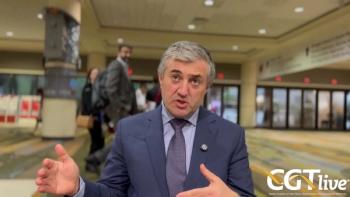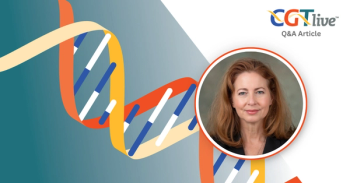
Assessing TCR-T Therapy in KRAS, EGFR, and TP53-Expressing Tumors
Maria Pia Morelli, MD, PhD, assistant professor at MD Anderson Cancer Center, discussed the first-in-human study of Sleeping Beauty TCR-T cells.
Sleeping Beauty T-cell receptor T-cell (TCR-T) therapy (Alaunos Therapeutics) had a manageable safety profile and showed signs of efficacy in patients with mutant KRAS, EGFR and TP53-expressing solid tumors, including non-small cell lung (NSCLC), colorectal, endometrial, pancreatic, ovarian and bile duct cancers. Data from the first 3 patients receiving 0.9 x 1010 TCR-T cells (dose level 1; n = 1) or 6.4 x 1010/5.8 x 1010 TCR-T cells (dose level 2; n = 2) were presented at the
Morelli and colleagues found that in overall best responses, Patient 1 (NSCLC) had a partial response with 6 month progression-free survival, Patient 2 (colorectal cancer) had stable disease and Patient 3 had progressive disease (pancreatic cancer). The 3 patients had cytokine release syndrome grades 2, 3 and 1, respectively, that were self-limiting or resolved with standard management and anti-IL-6 antibody (Patient 2). TCR-T cell persistence was observed in all patients at last follow-up (6 months for Patient 1). The trial may proceed to dose level 3 as long as safety continues to be manageable. CGTLive spoke with Morelli to learn more about the trial and the TCR-T therapy.
CGTLive: What are the potential advantages of using TCR therapy in these solid tumors?
Maria Pia Morelli, MD, PhD: With immune checkpoint inhibitors, there are diseases like colon cancer which are not hot tumors so the inhibitors will not work. Across different solid tumors, like lung cancer, only patients with high microsatellite instability can benefit from checkpoint inhibitors, which is around 10% of our patients and very limited. In this case, we can increase the types of patients that can benefit from a different type of immunotherapy. It's also only one dose, in hospital because patients need close monitoring from acute side effects. But, it’s just one dose and definitely a broader spectrum of patients that we can treat, especially with GI malignancies.
Is there other similar research that you or your colleagues are working on in the space?
Morelli: We have a lot of collaborations internally within MD Anderson, we have other clinical trials and also trials with biotechs, one of which is opening soon. So that'svery exciting. We do have a very interesting study that is all MD Anderson with NK cells for patients with colorectal cancer with minimal residual disease and we are enrolling also in this trial. We do have a trial for gastric cancer with a CAR that has shown very promising results. So yeah, there’s a lot of movement in the space, and here we have a lot of internal collaborations, so I do assist in research to bring new products, new trials to our patient for any stage of cancer. We are focused on the GI here, but the center is involved with a number of cell therapy trials.
What questions still need to be answered with TCR-T or cell therapies in general?
Morelli: A couple of things are absolutely important to understandthe more we use these treatments. I believe that at some point, we will see which disease is going to be more responsive. But, what's very important is understanding how the tumor microenvironment (TME) plays a role with this technology, becausewe are giving activated lymphocytes that have been modified or activated and expanded NK cells, but can these cells really get into the tumor and once they get into the tumor, what happens there? Even if they have the right target, what inhibitory mechanisms do the tumors have that can stop the cells from acting on them? All of these aspects need to be better understood.
The first part is understanding safety and feasibility. Is this possible? Is this safe for our patient? And also, which stage of disease should we focus on?But now, the more that we understand and the more cell therapies we have, we need to understand a little better how they could interact with the TME. Of course, we still need to refine finding the right target, and making sure that this target is as specific for the tumor as psosibleand not expressed by the healthy tissue. These are some of the challenges that we still need to work on.
Transcript has been edited for clarity.
REFERENCE
Morelli MP, Negrao MV, Collinson-Pautz MR, et al. Safety and efficacy of Sleeping Beauty TCR-T cells targeting shared KRAS and TP53 mutations expressed by solid tumors in first-in-human phase 1 study. Presented at: 2023 ASCO Meeting; June 2-6; Chicago, Illinois. Poster #389
Newsletter
Stay at the forefront of cutting-edge science with CGT—your direct line to expert insights, breakthrough data, and real-time coverage of the latest advancements in cell and gene therapy.


















































